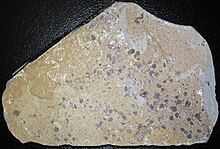| Morania Temporal range:
| |
|---|---|

| |
| Morania fragmenta fossil from Millard County, Utah | |
| Scientific classification | |
| Domain: | |
| Phylum: | |
| Genus: | Morania
|
Morania is a genus of cyanobacterium preserved as carbonaceous films [1] in the Middle Cambrian Burgess Shale. [2] it is present throughout the shale; [3] 2580 specimens of Morania are known from the Greater Phyllopod bed, where they comprise 4.90% of the community. [2] It is filamentous, [1] forms sheets, [3] and resembles the modern cyanobacterium Nostoc. [1] It would have had a role in binding the sediment, [3] and would have been a food source for such organisms as Odontogriphus and Wiwaxia. [3]
- ^ a b c Carroll Lane Fenton (1943). "Pre-Cambrian and Early Paleozoic algae". American Midland Naturalist. 30 (1): 83–111. doi: 10.2307/2421265. JSTOR 2421265.
- ^ a b Caron, Jean-Bernard; Jackson, Donald A. (October 2006). "Taphonomy of the Greater Phyllopod Bed community, Burgess Shale". PALAIOS. 21 (5): 451–65. Bibcode: 2006Palai..21..451C. doi: 10.2110/palo.2003.P05-070R. JSTOR 20173022. S2CID 53646959.
- ^ a b c d Caron, J. B.; Jackson, D. A. (2008). "Paleoecology of the Greater Phyllopod Bed community, Burgess Shale". Palaeogeography, Palaeoclimatology, Palaeoecology. 258 (3): 222–256. Bibcode: 2008PPP...258..222C. doi: 10.1016/j.palaeo.2007.05.023.
- "Morania confluens". Burgess Shale Fossil Gallery. Virtual Museum of Canada. 2011. Archived from the original on 2020-11-12.
| Morania Temporal range:
| |
|---|---|

| |
| Morania fragmenta fossil from Millard County, Utah | |
| Scientific classification | |
| Domain: | |
| Phylum: | |
| Genus: | Morania
|
Morania is a genus of cyanobacterium preserved as carbonaceous films [1] in the Middle Cambrian Burgess Shale. [2] it is present throughout the shale; [3] 2580 specimens of Morania are known from the Greater Phyllopod bed, where they comprise 4.90% of the community. [2] It is filamentous, [1] forms sheets, [3] and resembles the modern cyanobacterium Nostoc. [1] It would have had a role in binding the sediment, [3] and would have been a food source for such organisms as Odontogriphus and Wiwaxia. [3]
- ^ a b c Carroll Lane Fenton (1943). "Pre-Cambrian and Early Paleozoic algae". American Midland Naturalist. 30 (1): 83–111. doi: 10.2307/2421265. JSTOR 2421265.
- ^ a b Caron, Jean-Bernard; Jackson, Donald A. (October 2006). "Taphonomy of the Greater Phyllopod Bed community, Burgess Shale". PALAIOS. 21 (5): 451–65. Bibcode: 2006Palai..21..451C. doi: 10.2110/palo.2003.P05-070R. JSTOR 20173022. S2CID 53646959.
- ^ a b c d Caron, J. B.; Jackson, D. A. (2008). "Paleoecology of the Greater Phyllopod Bed community, Burgess Shale". Palaeogeography, Palaeoclimatology, Palaeoecology. 258 (3): 222–256. Bibcode: 2008PPP...258..222C. doi: 10.1016/j.palaeo.2007.05.023.
- "Morania confluens". Burgess Shale Fossil Gallery. Virtual Museum of Canada. 2011. Archived from the original on 2020-11-12.